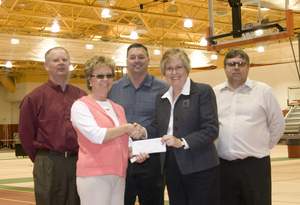NPPD presents another rebate for energy efficiency

For the second time this year, Chadron State College has turned its efforts of energy efficiency into a sizable rebate check.
Representatives from the Nebraska Public Power District were on campus Monday to present $15,592.80 to CSC for changes made to lighting in the Ross Armstrong Physical Education Building and the Nelson Physical Activity Center. The funds are made possible through NPPD’s EnergyWise incentive program.
Bryce Landen, NPPD energy efficiency consultant, and Terry Rajewich, NPPD account manager, delivered the funds, which add to a rebate of more than $27,000 in January for efforts in Old Admin and Sparks Hall.
The recent improvements include 140 lights replaced, a majority of which were changed from 400-watt metal halides to 400-watt metal halide pulse starts. Incandescents also were replaced by metal halide pulse starts.
The changes reflected an annual projected reduction of 155,928 kilowatt hours, or 35.6 kilowatts of demand. In all, the college has reduced its total kilowatts of demand this year by 115.23 kilowatts of demand.
“This was yet another great opportunity to lower some of our operating costs at Chadron State College through the changes of our lighting program,” said Dale Grant, CSC vice president for administration. “NPPD’s EnergyWise program allows us to cut our energy use, which has resulted in savings, while still maintaining a quality level of lighting for our staff and students.”
Grant said the institution is using the rebate money for other lighting upgrades on campus. Next up, he said, is the Math and Science Building.
NPPD’s Commercial, Industrial, and Area Lighting Efficiency Program offers cash incentives to help cover the cost of a variety of energy-efficient upgrades. On average, interior lighting accounts for 28 percent of a business’ energy consumption. NPPD officials also say the lights also are a contributing factor to a facility’s productivity, employee morale and safety. Lighting technologies developed during the past 10 years can help cut lighting costs 30 to 60 percent while enhancing lighting quality and reducing environmental impacts.
Category: Campus News

